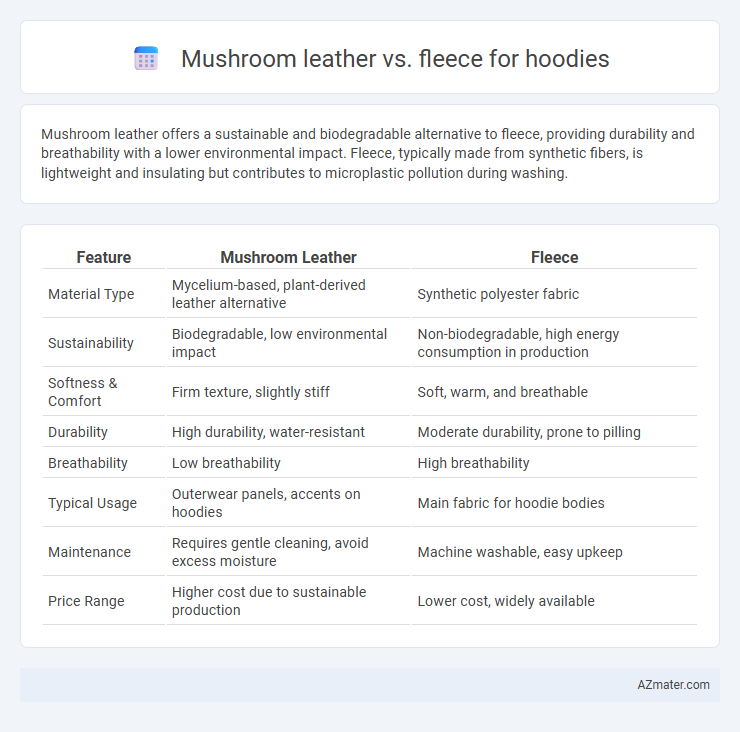Mushroom leather offers a sustainable and biodegradable alternative to fleece, providing durability and breathability with a lower environmental impact. Fleece, typically made from synthetic fibers, is lightweight and insulating but contributes to microplastic pollution during washing.
Table of Comparison
| Feature | Mushroom Leather | Fleece |
|---|---|---|
| Material Type | Mycelium-based, plant-derived leather alternative | Synthetic polyester fabric |
| Sustainability | Biodegradable, low environmental impact | Non-biodegradable, high energy consumption in production |
| Softness & Comfort | Firm texture, slightly stiff | Soft, warm, and breathable |
| Durability | High durability, water-resistant | Moderate durability, prone to pilling |
| Breathability | Low breathability | High breathability |
| Typical Usage | Outerwear panels, accents on hoodies | Main fabric for hoodie bodies |
| Maintenance | Requires gentle cleaning, avoid excess moisture | Machine washable, easy upkeep |
| Price Range | Higher cost due to sustainable production | Lower cost, widely available |
Introduction to Sustainable Hoodie Materials
Mushroom leather and fleece represent two innovative materials transforming sustainable hoodie production. Mushroom leather, derived from mycelium, offers a biodegradable alternative to traditional animal leather, reducing environmental impact through lower water usage and faster biodegradability. Fleece, often made from recycled polyester, provides warmth and durability while repurposing plastic waste, which helps minimize landfill contributions and fossil fuel consumption.
What is Mushroom Leather?
Mushroom leather, also known as mycelium leather, is a sustainable, biodegradable material created from the root structure of mushrooms, offering an eco-friendly alternative to traditional animal leather. It provides durability and a soft, flexible texture ideal for apparel like hoodies, while reducing environmental impact by using renewable resources. Compared to fleece, mushroom leather offers enhanced water resistance and breathability, making it a versatile choice for fashion-conscious consumers seeking sustainable options.
What is Fleece Fabric?
Fleece fabric is a soft, synthetic material made primarily from polyester fibers, designed to provide lightweight insulation and moisture-wicking properties. It is known for its warmth, breathability, and durability, making it a popular choice for hoodies and outdoor apparel. Compared to mushroom leather, fleece offers superior flexibility and comfort, though it lacks the sustainability and natural origin associated with mushroom-based materials.
Environmental Impact: Mushroom Leather vs Fleece
Mushroom leather, derived from sustainable mycelium growth, offers a biodegradable and low-impact alternative to traditional textiles, significantly reducing plastic pollution and carbon emissions compared to fleece. Fleece, typically made from petroleum-based polyester, contributes to microplastic pollution in waterways and relies on fossil fuels for production, increasing its environmental footprint. Choosing mushroom leather for hoodies supports circular fashion initiatives by minimizing landfill waste and conserving natural resources.
Breathability and Comfort Comparison
Mushroom leather offers moderate breathability due to its porous structure, providing a comfortable fit but may feel less flexible compared to fleece. Fleece excels in breathability and moisture-wicking properties, ensuring superior comfort and softness for hoodies, making it ideal for active wear. The choice between mushroom leather and fleece depends on prioritizing durability and unique texture versus enhanced ventilation and plush comfort.
Durability and Longevity Analysis
Mushroom leather, derived from mycelium, offers impressive durability with resistance to wear, stretching, and tearing, making it a sustainable yet long-lasting alternative for hoodie material. Fleece, typically made from polyester, excels in softness and thermal insulation but tends to pill and degrade faster with frequent washing, reducing its lifespan. When comparing durability and longevity, mushroom leather provides enhanced structural integrity and environmental benefits, while fleece prioritizes comfort at the expense of enduring wear.
Style and Aesthetic Differences
Mushroom leather offers a sleek, modern aesthetic with a smooth, polished finish that adds a luxury edge to hoodies, making them stand out as eco-friendly fashion statements. Fleece, on the other hand, provides a soft, cozy texture with a casual, relaxed look that emphasizes comfort and warmth over sophistication. The contrast between mushroom leather's structured appearance and fleece's plush feel defines distinct style choices catering to either upscale or everyday streetwear.
Cost Comparison and Market Availability
Mushroom leather, derived from mycelium, typically costs more than traditional fleece due to its sustainable production process and emerging market status. Fleece, made predominantly from polyester, remains widely available and affordable, dominating the hoodie textile market with its low manufacturing costs. While mushroom leather offers eco-friendly benefits, its limited production scale restricts market availability compared to the mass-produced, cost-effective fleece options.
Care and Maintenance Requirements
Mushroom leather hoodies require gentle cleaning with a damp cloth and mild soap, avoiding machine washing to prevent material degradation, while fleece hoodies can typically be machine washed and dried, offering easier care and maintenance. Mushroom leather is biodegradable and often needs conditioning to maintain flexibility and prevent cracking over time. Fleece is durable and resistant to shrinkage or pilling with proper washing, making it more convenient for frequent use.
Which Material is Best for Hoodies?
Mushroom leather offers a sustainable, biodegradable, and breathable alternative to fleece, making it ideal for eco-conscious hoodie designs that prioritize comfort and durability. Fleece, made from synthetic fibers, excels in providing superior warmth, moisture-wicking properties, and lightweight insulation suitable for active wear. For hoodies, mushroom leather is best for eco-friendly fashion with a unique texture, while fleece remains preferred for thermal performance and everyday practicality.

Infographic: Mushroom leather vs Fleece for Hoodie
 azmater.com
azmater.com